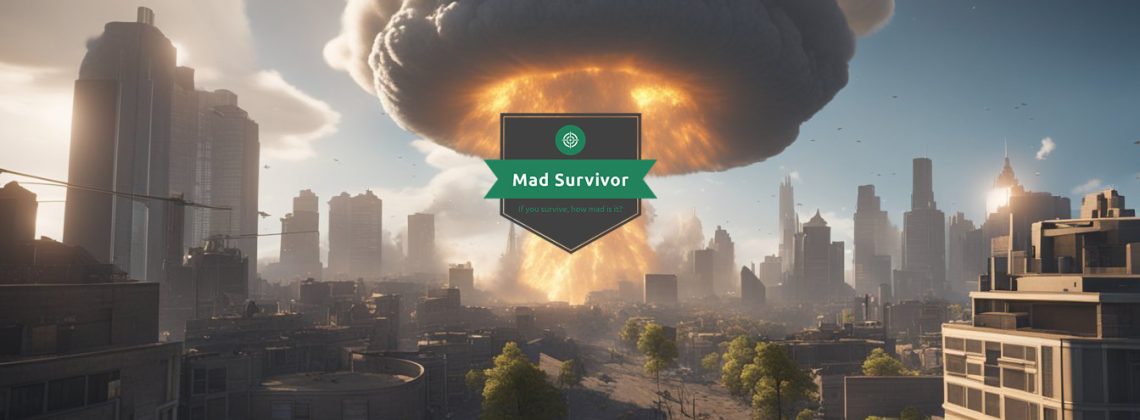
Surviving a nuclear blast may seem like a scenario out of a doomsday prepper’s guidebook, but the reality of modern times makes it a subject worth knowing about. A nuclear explosion is a devastating event that can result in immense destruction, as seen in the historical events of Hiroshima and Nagasaki. If you ever find yourself in such a situation, understanding the basics of nuclear survival can significantly increase your chances of staying safe.
When a nuclear blast occurs, your immediate priority is to protect yourself from the blast itself and the subsequent radiation exposure. This means finding the most substantial shelter available to you as quickly as possible. After the initial detonation, the fallout, which includes a mix of radioactive particles that descend from the sky, becomes a pressing concern. It’s essential to plan to shelter in place for an extended period, at least 48 hours or until it’s safe to evacuate to a less contaminated area.
Preparation, while vital, is only half the battle – the other half relies on luck and the situational factors beyond your control. Still, making informed decisions in these moments can drastically improve your odds of survival. It’s important to have a plan, remain calm, and be ready to execute survival strategies without hesitation. Remember, while no one can predict the future, awareness and preparation can empower you to face the unpredictable with confidence.
Jump To Section
- Understanding Nuclear Blasts
- Immediate Response to a Nuclear Blast
- Long-Term Survival Strategies
- Infrastructure and Shelter Building
- Dealing with Environmental Hazards
- Legal and Social Implications
- Future Perspectives
- Survival Stories and Analysis
Understanding Nuclear Blasts
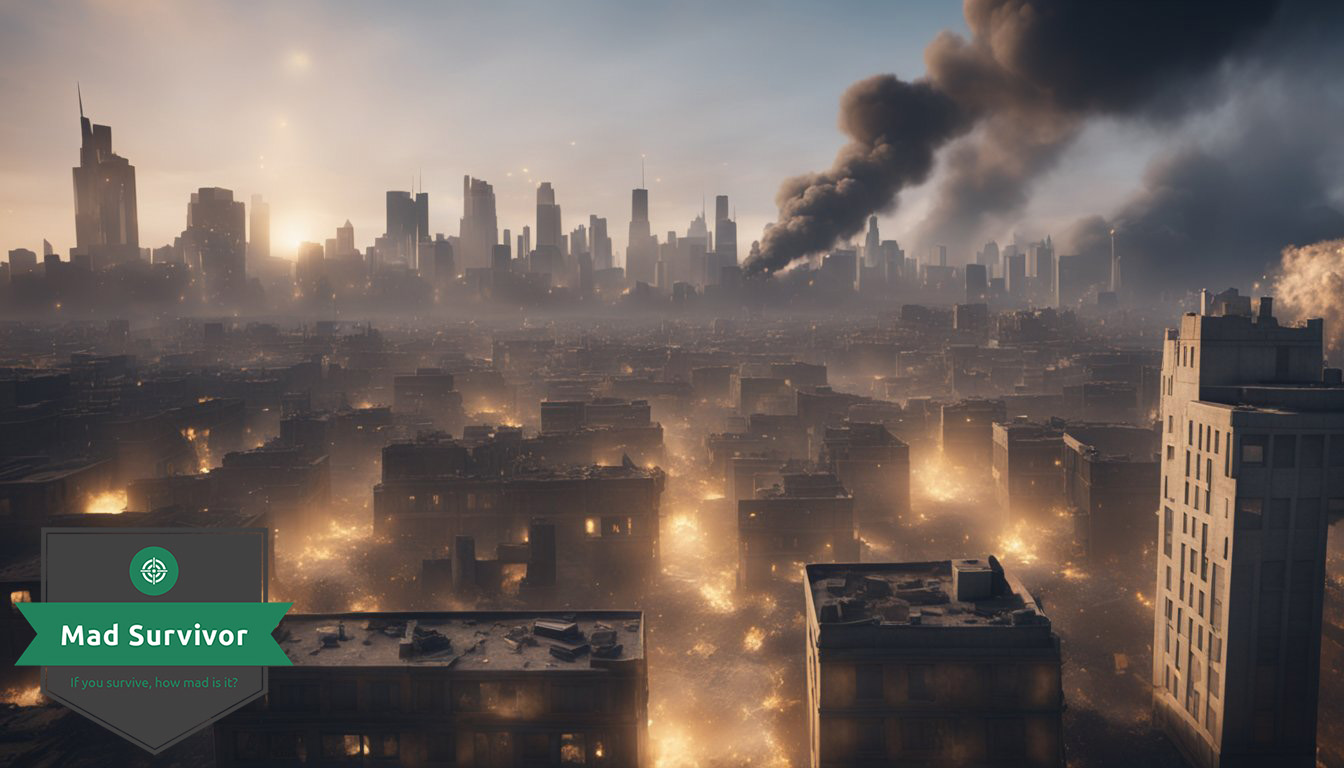
When discussing how to survive a nuclear blast, it’s essential to grasp the mechanisms and aftermath of such an event. Your awareness of the science, history, and current threats can significantly enhance your chances of survival.
Physics of a Nuclear Explosion
A nuclear explosion is a complex event with immediate and long-term effects. The fireball created by a nuclear blast is a sphere of superheated air and plasma. The shock wave and subsequent blast wave are powerful surges of pressure that expand from the explosion at supersonic speeds, devastating the surrounding area. Heat and radiation are emitted in lethal amounts, causing everything from burns to radiation poisoning.
Effects of Nuclear Weapons
The consequences of a nuclear weapon detonation are catastrophic. Along with the initial blast and heat, you’d encounter fallout, a dangerous mix of radioactive particles that descend from the mushroom cloud. Radiation can range from gamma rays to neutrons, which can cause acute illnesses and increase the risk of cancer. Protection is key; even a concrete structure can offer some shelter from the pressure and shock waves.
Historical Context
The devastation at Hiroshima and Nagasaki during the Cold War provides a grim reminder of the power of nuclear weapons. As a fallout of those events, the world has since grappled with the threat of an all-out nuclear war. Survival strategies arose from studying these historical uses of nuclear bombs.
Political Landscape
In today’s political climate, countries like Russia, Ukraine, India, Pakistan, North Korea, and China are key players in the realm of nuclear weaponry. As a doomsday prepper, keeping informed about international affairs, and international bodies like NATO, could be vital for predicting potential conflict scenarios.
Scientific Insights
Recent studies, like those by Dimitris Drikakis at the University of Nicosia and publications in Physics of Fluids, have examined the effects of blast waves in urban environments. The Union of Concerned Scientists and the Bulletin of the Atomic Scientists provide information that can deepen your understanding of nuclear phenomena.
Potential Conflict Scenarios
Entries from the search results indicate emerging conflicts and the potential use of ICBMs or invasions could lead to a nuclear strike. As a survivalist, analyze these scenarios to better plan for sheltering strategies and post-blast survival. Knowledge and preparedness for these occurrences are crucial for ensuring your safety during and after a nuclear event.
Immediate Response to a Nuclear Blast
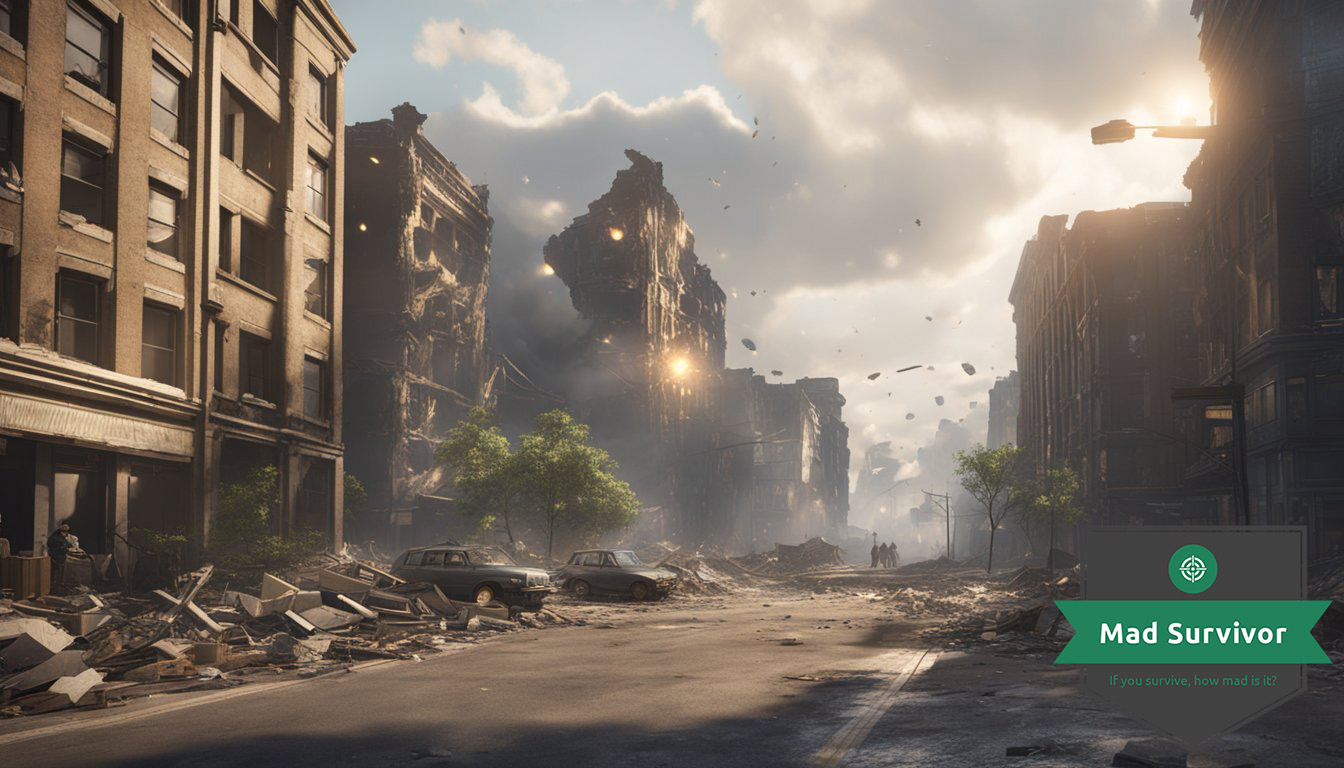
In the face of a nuclear detonation, your immediate actions are critical for survival. Attention to warnings, seeking adequate shelter, and shielding yourself from the blast and fallout can significantly increase your chances.
Recognizing the Warning Signs
Stay alert for official emergency alerts that might indicate a nuclear threat. This could manifest as intense flashes of light or unexpected emergency broadcasts on your radio or TV. Recognizing these signs promptly will give you crucial moments to react.
Finding Shelter
Your priority should be to find the most secure shelter possible:
- Concrete buildings: Prefer a brick or concrete building with a basement.
- Underground: If accessible, underground locations offer the best protection against the initial blast.
Protecting Yourself During the Blast
When the blast occurs:
- Close all doors and windows: Seal your space as best as possible.
- Avoid windows: Stay in the corner of a room away from windows to minimize exposure to the blast.
Safety Precautions Post-Detonation
Following the blast, protect yourself from the fallout:
- Clothing: Put on long-sleeved clothing to cover your skin against radioactive debris.
- Clean air: If you suspect the air is contaminated, use a cloth to cover your mouth and nose.
Evacuation Strategies
If evacuation is viable:
- Plan ahead: Have a pre-planned route to designated fallout shelters.
- Stay informed: Use a battery-powered radio to receive updates on evacuation orders and the status of fallout.
Long-Term Survival Strategies
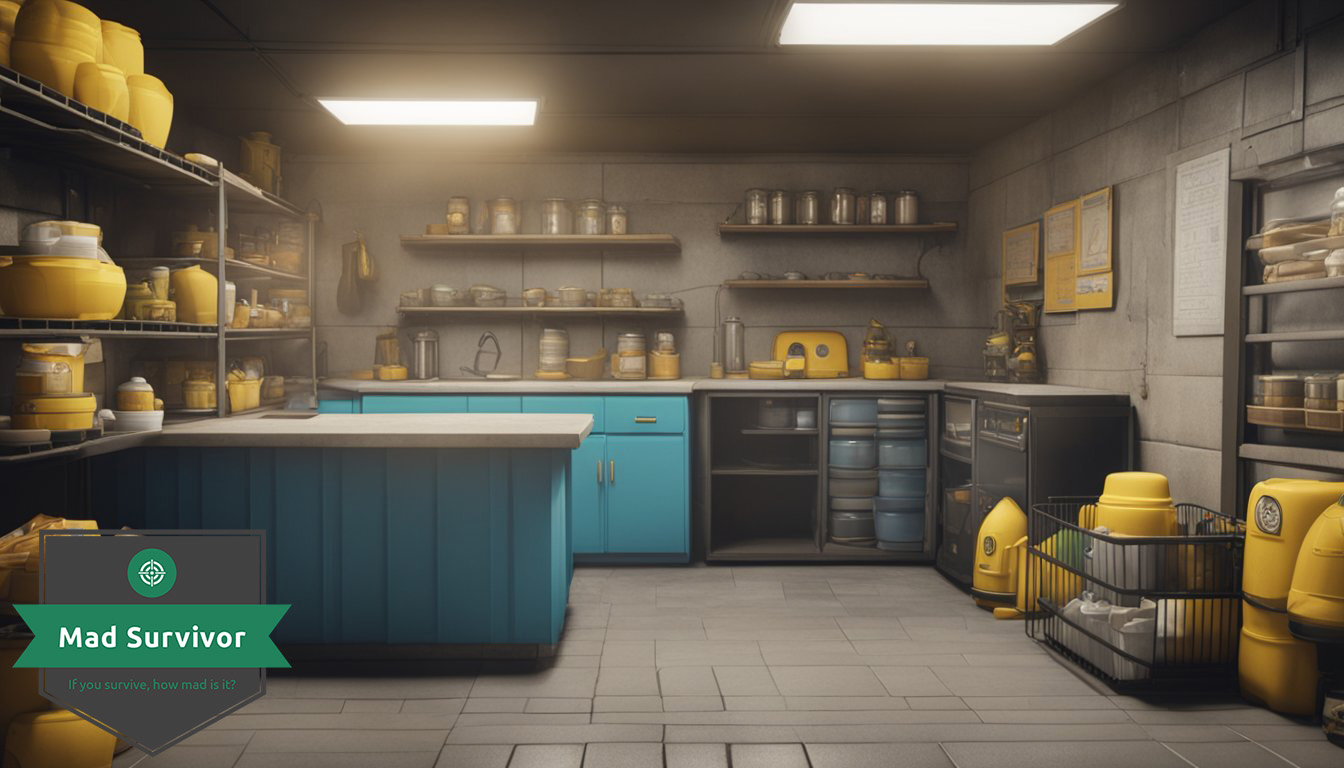
After a nuclear blast, your goal is to maintain safety and meet basic needs indefinitely. Establishing a sustainable living condition is essential as conventional services may be unavailable.
Securing Food and Water
You’ll need a steady supply of non-perishable food and potable water. Stock up on:
- Canned goods: fruits, vegetables, meats
- Dry staples: rice, beans, lentils
- Water purification methods: tablets, filters
Store at least one gallon of water per person per day and consider rainwater collection systems. Rotate your food supply to maintain freshness.
Health and First Aid
Be ready to handle common injuries and illnesses, especially those related to radiation. Have a comprehensive first aid kit that includes:
- Burn ointments
- Radiation sickness treatments
- Potassium iodide tablets to protect your thyroid
Learn basic first aid and recognize symptoms of serious conditions like radiation poisoning.
Preparation and Supplies
Your survival hinges on proper preparation. Your shelter should be well-stocked with essential supplies:
- Battery-powered or hand-crank radio: to stay informed
- Tools: for repair and construction
- Protective gear: masks, gloves
Stay connected with survivors through social media (if possible), as community support is vital.
Mental Well-Being and Community
Maintaining your mental health is crucial:
- Establish a daily routine
- Connect with nearby survivors and build a support network
Regular contact with others can improve your mental state and provide shared resources for survival.
Infrastructure and Shelter Building
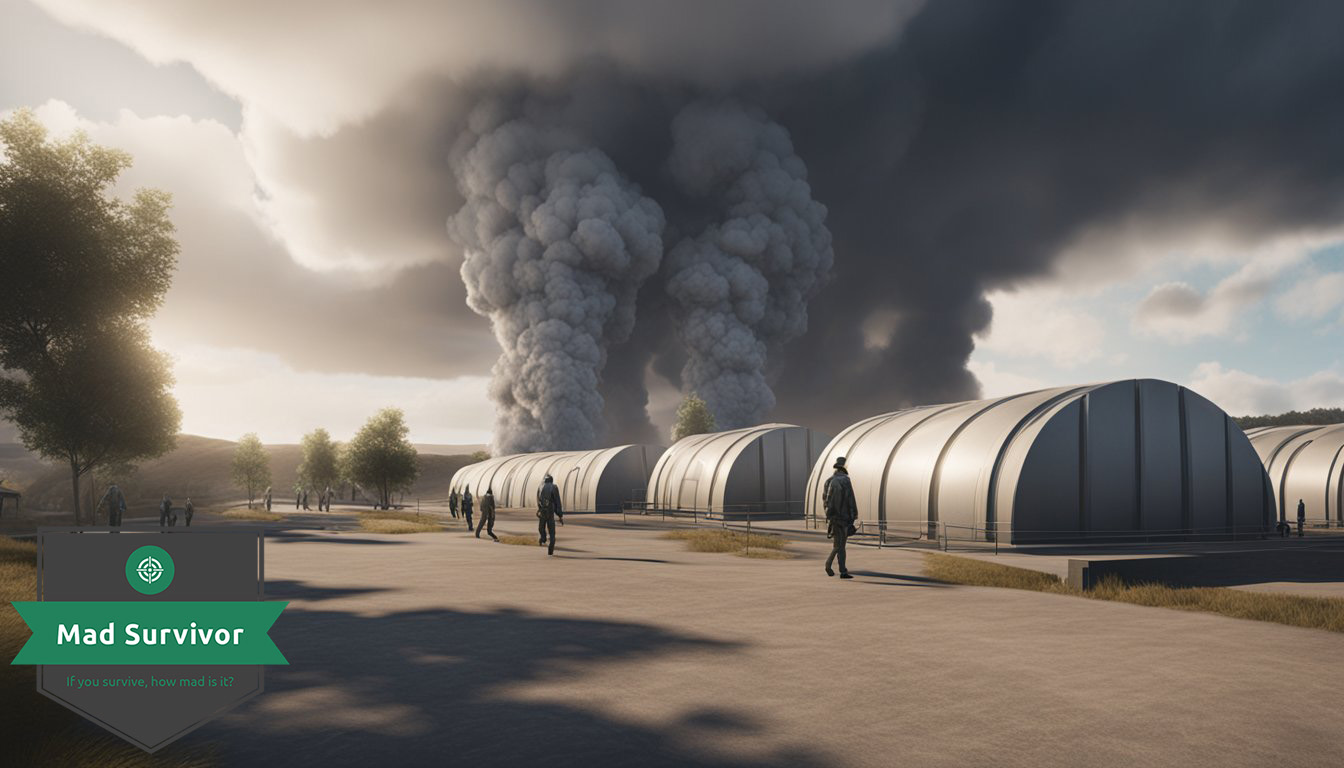
In the event of a nuclear explosion, your survival greatly depends on the protective strength of your shelter. Let’s go over how you can construct spaces with survivability in mind, and how to make the best use of existing structures.
Constructing Protective Spaces
When you’re planning to construct a shelter, it’s important to choose materials that will effectively shield you from the blast and fallout. Concrete is your best friend here – it’s strong, dense, and widely available:
- Underground Bunkers: An underground concrete bunker is ideal. Bury it deep enough (optimally more than 10 feet underground), and ensure it is completely enclosed.
- Walls: The thicker, the better. Aim for at least two feet thick concrete walls.
- Doors: They should be heavyweight and form a tight seal to keep fallout particles out.
Reinforce the structure with steel if possible, and equip your bunker with filtering systems for air and water, as fallout can contaminate supplies for a considerable time after the blast.
Utilizing Existing Structures
If constructing a bunker isn’t feasible, knowing how to use existing structures to your advantage is vital. Opt for buildings made predominantly of concrete:
- Subterranean Spaces: Like subways and basements, provide a buffer from the blast and are generally more secure against fallout.
- Inner Rooms: In a home or building, choose central rooms with no exterior walls. Corners can offer additional structural integrity.
- Bank Vaults: Often built with thick concrete walls, they could provide makeshift shelters.
The goal is to put as much sturdy material between you and the exterior as possible to protect from initial radiation, the pressure wave, and then the subsequent fallout. Remember, the more barriers, the better.
Dealing with Environmental Hazards
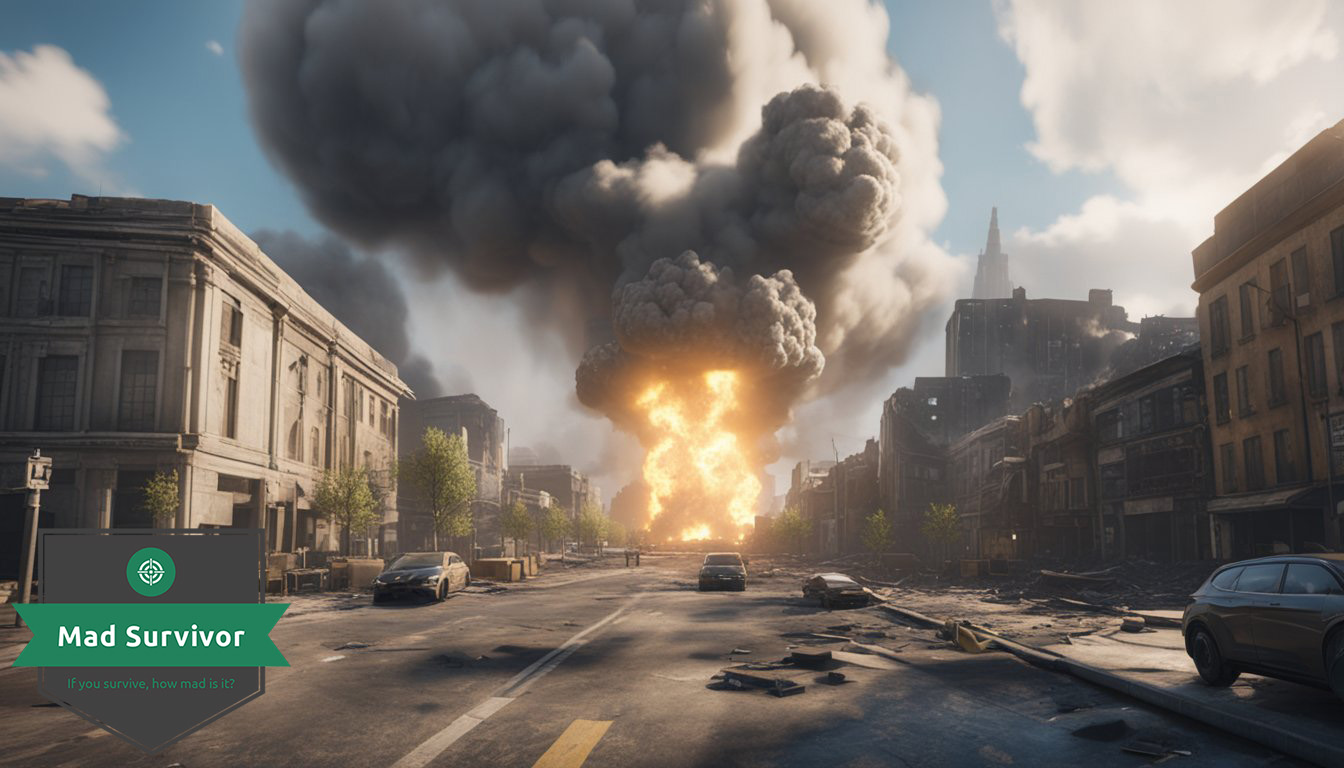
Surviving a nuclear blast involves not only avoiding the initial impact but also dealing with the resulting environmental hazards. Your health is severely threatened by radiation exposure and radioactive fallout, making knowledge of safety measures essential.
Mitigating Radiation Exposure
Radiation poses a grave risk to all life forms after a nuclear detonation. Gamma radiation, being the most penetrating type, requires you to have substantial shielding to protect yourself. Here’s what you can do:
- Distance: The farther away you are from the source, the less radiation you’ll be exposed to. Distance is a key factor in safety.
- Shielding: Dense materials like lead and concrete are your best bet against radiation. Even thick walls and earth can provide some protection, so look for shelter that puts as much material between you and the outside as possible.
- Time: Radiation intensity decreases with time after the blast, so you should stay sheltered for at least 48 to 72 hours, as the first hours to days are the most hazardous.
Protection Against Radioactive Fallout
Radioactive fallout consists of microscopic particles of radioactive material that descend from the atmosphere after a nuclear explosion. Here’s how to protect yourself from these dangers:
- Shelter: Stay indoors or underground. An ideal fallout shelter is airtight and has no windows, with several inches of concrete or packed earth overhead.
- Sanitize: If you’ve been outside, remove and bag your clothing, and vigorously wash all parts of your body to remove fallout particles.
- Air Filtration: Use air purifiers or create positive pressure in a room to keep fallout particles out.
- Detection: Obtain radiation detection devices to measure the level of radioactivity in gray units so you know when it’s safe to exit the shelter.
Adopting these measures will significantly improve your chances of staying safe in the aftermath of a nuclear blast.
Legal and Social Implications
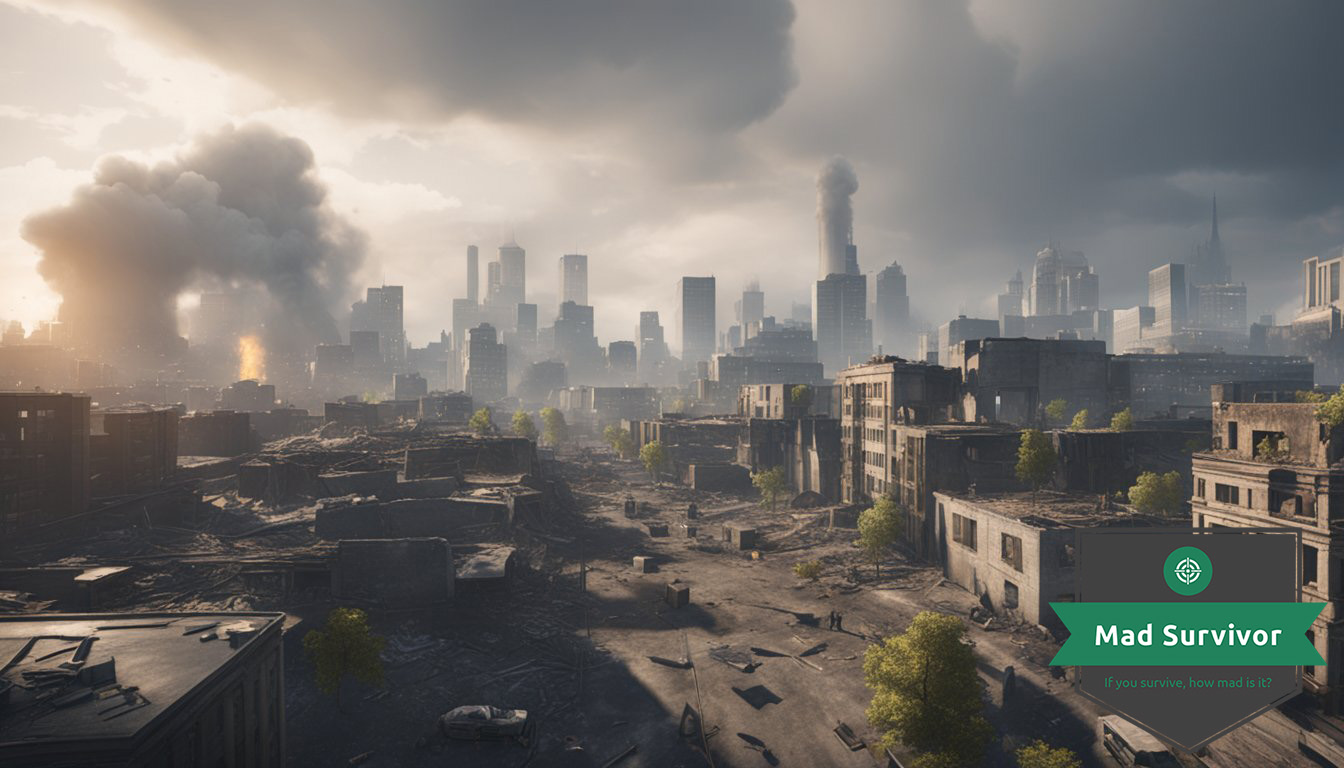
In the wake of a nuclear blast, the importance of legal frameworks and social cohesion can’t be overstated. These underpin both your immediate and long-term survival prospects as well as the broader efforts to rebuild and respond to such a catastrophe.
Nuclear Policies and Government Response
U.S. Policies and Preparedness: In the United States, the federal government has established nuclear policies and an infrastructure geared towards minimizing the impact of a nuclear detonation. The President, along with federal agencies such as the Centers for Disease Control and Prevention (CDC), has a pivotal role in shaping these policies. In an emergency, the Emergency Alert System will broadcast vital information, guiding you to safety.
- Key Agencies Involved:
- Department of Defense (DoD) – Manages nuclear warhead inventory.
- Federal Emergency Management Agency (FEMA) – Organizes disaster response.
Your Action Plan:
- Stay informed about local emergency protocols.
- Pay attention to alerts and directives from officials.
Legal Consequences: Post-blast, expect restrictions aimed at ensuring public safety and order. These might include curfews and limited access to certain areas due to potential radioactive contamination or rescue operations.
Community and Global Reactions
Survivors’ Network and Recovery: In the aftermath, social networks and community solidarity become crucial. Local support groups may form, providing psychological support and sharing resources, while international bodies like NATO may play a role in relief efforts.
- How You Can Contribute:
- Participate in community preparedness drills.
- Volunteer with local disaster response teams.
Global Reactions: The global community typically responds to a nuclear incident with humanitarian aid, and there may be diplomatic efforts to prevent further escalation. News of the devastation and the number of fatalities will shape international discourse and may lead to changes in nuclear policies.
Building a Resilient Community:
- Engage with local authorities to better understand regional risks and safety strategies.
- Build relationships with neighbors to strengthen community bonds and increase mutual aid in times of crisis.
By being well-informed and actively involved in your community’s preparations, you can bolster your resilience to a nuclear blast and its aftermath.
Future Perspectives
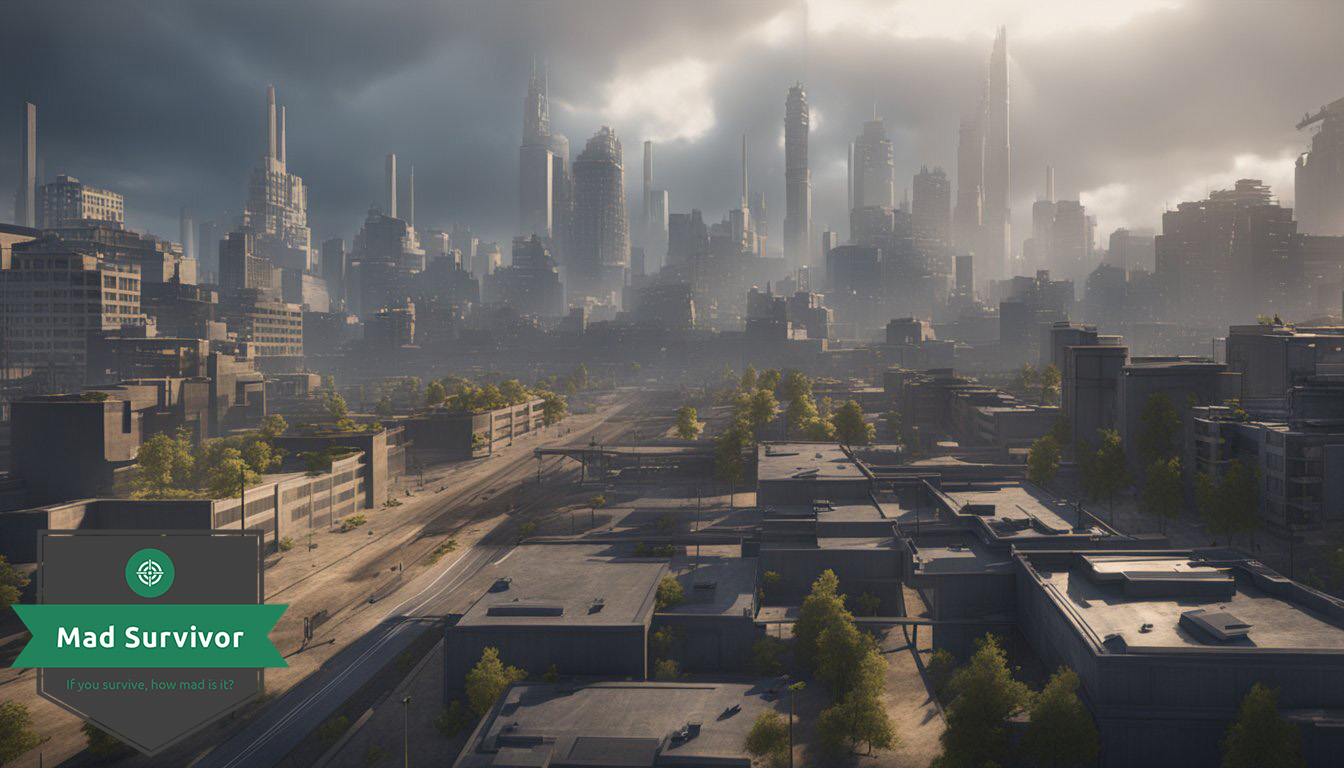
As a survival enthusiast or a doomsday prepper, understanding the influence of future technology on nuclear survivability is crucial. It offers insight into protective measures against modern nuclear weapons and the dreaded aftermath of a nuclear blast, including nuclear fallout and nuclear winter.
Technological Advancements
Modern Nuclear Weapons: The advancements in nuclear weapons technology, particularly in the development of ICBMs (Intercontinental Ballistic Missiles), make survival more challenging. Newer warheads are more powerful and precise, which underscores the need for updated survival strategies.
Survival Tips: Your chance of survival will improve significantly with the integration of futuristic shielding materials and construction techniques in shelters. Keep an eye on advancements in radiation-proof and heat-resistant materials that may provide better protection against the intense heat and blast effects of modern nuclear weapons.
Nuclear Fallout: Contemporary tech developments could yield advanced filtration and ventilation systems that can remove radioactive particles more effectively, ensuring a safer breathing environment in the post-blast scenario. Such systems should be a key consideration in your survival shelter design to safeguard against potential radioactive exposure.
Nuclear Winter: Preparing for a nuclear winter scenario entails understanding climate science’s future predictions. Ensure your shelter is equipped to sustain long-term living conditions, as nuclear winter can lead to catastrophic climatic changes and a considerable drop in temperature.
Incorporating these future technological outlooks into your survival planning will not only increase your knowledge but also bolster your resilience against the ever-evolving threat of nuclear conflict. Stay informed and well-prepared, for your survival may one day depend on it.
Survival Stories and Analysis
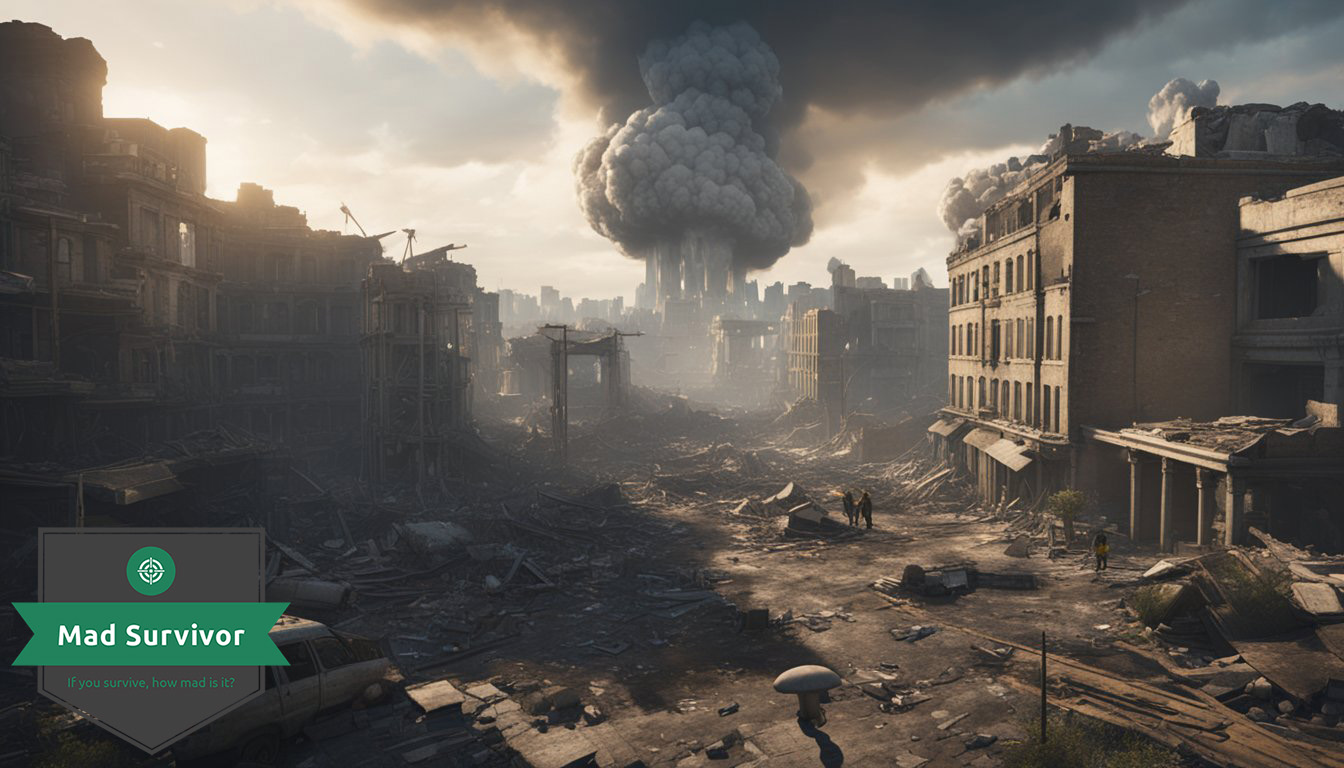
This section dives into remarkable survival tales from the past and analyzes strategies to confront a nuclear event. Learn from the experiences of those who lived through Hiroshima and Nagasaki, how modern preppers gear up for such scenarios, and what experts suggest to maximize survivability.
Accounts from Hiroshima and Nagasaki
During the atomic bombings of Hiroshima and Nagasaki, some residents miraculously survived. The common thread in these stories is the importance of immediate shelter. Those who escaped the worst effects did so by being in sturdy buildings, away from windows, and at a distance from the blast’s epicenter.
Survivor Accounts:
- Seek immediate shelter—structures can provide crucial protection.
- Distance from the blast center is a key survival factor.
Modern-Day Preppers’ Strategies
Your modern preparation strategies can draw inspiration from preppers. Their approaches cover constructing robust bunkers and creating stockpiles of essentials.
Preparation Checklist:
- Secure a well-constructed shelter like a bunker.
- Gather supplies: food, water, first aid, and radiation detectors.
Expert Opinions
The Union of Concerned Scientists shares comprehensive guidance on survival after a nuclear blast. They emphasize the need for knowledge about the particular risks of nuclear fallout.
Expert Tips:
- If possible, aim to reach a safer location within 30 minutes post-explosion.
- Understand the fallout’s duration and how to decontaminate yourself to reduce exposure.
Remember, while these stories and tips provide a framework for survival, adapting to the specifics of any given situation is crucial for your safety.

Leave a Reply